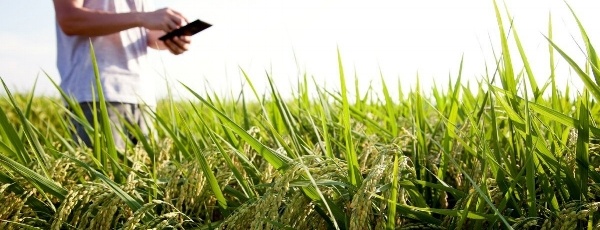Water is one of the biggest factors of determining crop yield on farms today. And while farmers often feel at the mercy of Mother Nature, there are many effective strategies we can leverage to help turn the tables on soil moisture problems and manage available water to hit top yields.
One of the industry’s top water experts says that by dialing in a 'whole-farm water management strategy', farmers can:
- Improve crop yields by as much as 30 percent in Year One
- Improve nutrient availability and absorption by having a more developed root zone
- Significantly reduce field compaction and soil erosion
- Greatly improve the farm’s chances of having a more consistent crop year after year.
“Water is the most critical input on the farm today — and it’s one that many farmers struggle to properly manage,” says Josh Shuler, a product manager with Trimble Agriculture who specializes in water management. “But at the end of the day, all other input decisions should hinge on how it is being managed.”
Shuler describes water as the scarcest nutrient in dry-land agriculture today. Yet, it’s also the most under-managed across all of agriculture today, regardless of its availability. “Even if you aren’t growing in a semi-arid, or sub-humid region, water is the most critical input, and many farmers struggle to understand the true impact the lack of water management can have on their operation,” Shuler says. “All other input decisions should hinge on how water is managed.”

For most crops, it takes anywhere from 4-20 acre-inches of water just to grow the crop to full, mature size. For corn, it takes about 0.14 acre-inches (approx. 4000 gal) of water per bushel over the entire growing season. To put that in perspective, a 250-bushel corn crop requires nearly 35 acre-inches of water (or about 992,000 gallons per acre) to reach full its full nutrient-limited potential. Every inch of water beyond this goes toward increasing your yield to it’s ultimate hybrid and/or nutrient-supplied limit
However, as with any crop input, water must be in the proper proportion and available at the right stage of development for maximum potential yields. Too much, or too little, water during these critical developmental phases can result in significantly reduced yields, even if the total water supply across the growing season, and all your other input decisions were right on the money.
Precipitation, irrigation and the water-holding capacity of your soil all contribute to the available water tally for your crops, and thus your ultimate yields. In this blog, Shuler is going to focus on some of the less understood factors: field topography, soil type, soil fertility, and water availability (soil water holding capacity).
Topography
First let’s talk about a field's varied topography. Having an accurate survey and representation of your farmland topography is an invaluable tool. Steep slopes where erosion can deprive you of valuable topsoil, or depressions where ponding occurs, are obvious red flags, but there are other subtle shifts in topography that can be just as detrimental to your crops’ potential — and severely limit your yields as well. Dense and thorough land surveys using GPS tools, like WM-Survey, with precision RTK accuracy, are absolutely essential to identifying all steep slopes, subtle and substantial rises and low spots, and other subtle features where action needs to be taken to improve crop yields.
Keep in mind that not all action needs to be extreme to remedy these features. Some are much easier than you think and the cost of the doing the work can be made back in as little as a single season. Most farmers over-estimate the cost of rectification and under-estimate the overall impact to their bottom-line those features, left undisturbed, really are. Often, the most effective approach to maximizing your ROI in this investment is to correct the sub-surface water table and the surface run-off effectively. It is very likely going to require at least a significant percentage of both activities to set up the most consistent yields possible.
Soil Type
Whether your soil is heavy sand, silt, clay, or some combination thereof, its composition greatly affects its ability to retain moisture and make it available to the planted crop. Clay soils are excellent at holding water, but they are also heavy and sticky not good at allowing excess water to move through quickly. Sandy soils are the opposite. They drain and percolate well due to their high hydraulic conductivity, but lack the ability to store any real quantity of moisture.
The appropriate spacing of tile throughout the entire field is mandatory to achieve adequate drainage and produce more consistent yields. If they are too far apart for that soil type, you cannot control the water table effectively and will have wet spots in between the runs; too close together and you waste money on excess tile and installation costs that weren’t necessary.
Fertility
Water can have a significant impact on soil fertility throughout the year. Heavy rain events, or over-irrigation, can cause significant erosion and wash away not only the thin layer of topsoil, but the precious organic matter and nutrients within it. Most of the organic matter present in any soil is found in that thin layer of topsoil and its loss directly reduces nutrient availability and a soil’s overall fertility... thus your yields.

Proper water management system designs, layout, spacing, and tile sizing needs to factor in large rain events during the two most crucial times of year, planting and harvest. Both of these critical time windows are already very short in some regions and the potential in lost yields can easily justify the investment in a complete water management system with little more than calculating what value buying back those crucial few days that you lose nearly every year really is in dollars and cents.
Nitrogen and phosphorus are two of the three most important nutrients your crop needs to meet its potential. They are also the two nutrients most susceptible to leaching due to water movement through the soil. Nitrates readily dissolve and drain to depths well below where plant roots can reach them if the water level remains high during the first 4-8 weeks of growth when the roots stop going deeper once they hit good water and nutrients. Phosphorus also leeches and moves downward in sandy soil. To combat this, a good understanding of soil composition and a good solid water management strategy are required to ensure that all of your other input decisions can help your crop consistently achieve its full potential year after year
Water Availability
Drainage systems are invaluable during spring when water is so abundant it can threaten new plantings and even your ability to plant during that small prime window. They’re also extremely important during the fall when you need dry crop conditions for a timely harvest.
 During the hotter, drier months of the summer, however, nature doesn’t always cooperate by providing enough water during that crucial period of crop fill to achieve viable yields, and that tile system in your field become even more valuable and extremely important for maximum profits. With the addition of controlled drainage structures, you can have positive control of the water table throughout the field.
During the hotter, drier months of the summer, however, nature doesn’t always cooperate by providing enough water during that crucial period of crop fill to achieve viable yields, and that tile system in your field become even more valuable and extremely important for maximum profits. With the addition of controlled drainage structures, you can have positive control of the water table throughout the field.
Utilizing water control gates can turn your traditional tile drainage system into a water retention system that keeps your water table at the appropriate level for the current crop stage. This type of system allows you to grow a crop that is more drought tolerant and less susceptible to common issues in wetter climates like stalk rot and other diseases that affect stalk and ear health and pest pressure.
With all these factors potentially affecting your yields, it's easy to see why proper water management is the solid foundation of every successful farm. Whether it’s too much, not enough, or its in the wrong place, water management impacts every grower in the world.
Trimble Agriculture has been a leader in the water management space for more than 50 years now. We love listening to our customers because they give us most of our best ideas. We take pride in developing specific products and the end-to-end solutions that solve our customers’ most pressing needs. Have questions or feedback for us? Let us know! TABS_AgAdvance@Trimble.com
Want to learn more? Check out this free e-book on how to track farm success.


